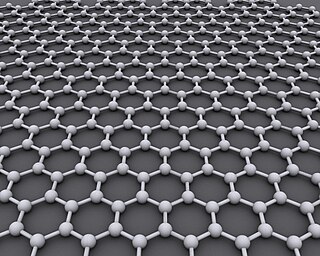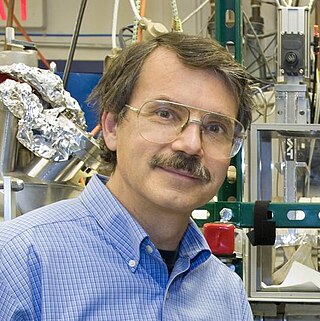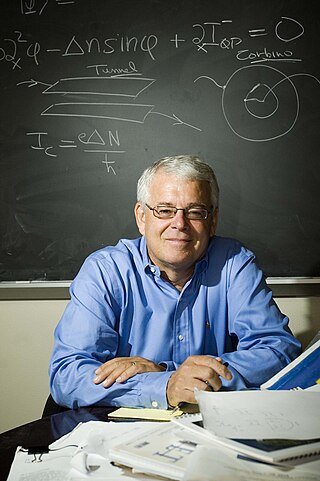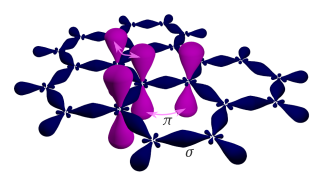
Graphene is a carbon allotrope consisting of a single layer of atoms arranged in a honeycomb planar nanostructure. The name "graphene" is derived from "graphite" and the suffix -ene, indicating the presence of double bonds within the carbon structure.

Alex K. Zettl is an American experimental physicist, educator, and inventor.

Sir Andre Konstantin Geim is a Russian-born Dutch–British physicist working in England in the School of Physics and Astronomy at the University of Manchester.
Katsunori Wakabayashi is a physicist at the International Center for Materials Nanoarchitectonics (MANA), National Institute for Materials Science (NIMS), Japan. He is an authority and leading researcher in nanotechnology in the area of energy states of single wall carbon nanotubes (SWCN). His research is notable for the edge effects of the nanographene materials, which is a part of the single layer graphene. He obtained his Ph.D. in 2000 from University of Tsukuba in Japan. From 2000 to 2009 he was an assistant professor at Department of Quantum Matter in Hiroshima University, Japan. From 2009, he is an Independent Scientist at International Center for Materials Nanoarchitectonics (WPI-MANA), National Institute for Materials Science (NIMS) in Tsukuba, Japan. Beside the above primary research position, he was a visiting scholar at ETH-Zurich, Switzerland from 2003 to 2005, also had a concurrent position as PRESTO researcher in Japan Science and Technology Agency (JST).

Sir Konstantin Sergeevich Novoselov is a Russian–British physicist. His work on graphene with Andre Geim earned them the Nobel Prize in Physics in 2010. Novoselov is a professor at the Centre for Advanced 2D Materials, National University of Singapore and is also the Langworthy Professor of the School of Physics and Astronomy at the University of Manchester.
Bilayer graphene is a material consisting of two layers of graphene. One of the first reports of bilayer graphene was in the seminal 2004 Science paper by Geim and colleagues, in which they described devices "which contained just one, two, or three atomic layers"
The Manchester Centre for Mesoscience and Nanotechnology is a centre for interdisciplinary research in mesoscience and nanotechnology headed by Andre Geim at the University of Manchester. The purpose of the centre is to allow researchers to construct devices from a few micrometres down to 10 nanometres in size. It was opened by Lord Sainsbury on 7 April 2003.

Allan H. MacDonald is a theoretical condensed matter physicist and the Sid W. Richardson Foundation Regents Chair Professor of Physics at The University of Texas at Austin. His research interests are centered on the electronic properties of electrons in metals and semiconductors. He is well known for his work on correlated many-electron states in low-dimensional systems. In 2020, he became one of the laureates of the Wolf Prize in Physics, for predicting the magic angle that turns twisted bilayer graphene into a superconductor.
Valleytronics is an experimental area in semiconductors that exploits local extrema ("valleys") in the electronic band structure. Certain semiconductors have multiple "valleys" in the electronic band structure of the first Brillouin zone, and are known as multivalley semiconductors. Valleytronics is the technology of control over the valley degree of freedom, a local maximum/minimum on the valence/conduction band, of such multivalley semiconductors.
A two-dimensional semiconductor is a type of natural semiconductor with thicknesses on the atomic scale. Geim and Novoselov et al. initiated the field in 2004 when they reported a new semiconducting material graphene, a flat monolayer of carbon atoms arranged in a 2D honeycomb lattice. A 2D monolayer semiconductor is significant because it exhibits stronger piezoelectric coupling than traditionally employed bulk forms. This coupling could enable applications. One research focus is on designing nanoelectronic components by the use of graphene as electrical conductor, hexagonal boron nitride as electrical insulator, and a transition metal dichalcogenide as semiconductor.
A rapidly increasing list of graphene production techniques have been developed to enable graphene's use in commercial applications.
Yuanbo Zhang is a condensed matter physicist and a professor of physics at Fudan University. He is known for his work on the electronic properties of low-dimensional systems.

In physics, Dirac cones are features that occur in some electronic band structures that describe unusual electron transport properties of materials like graphene and topological insulators. In these materials, at energies near the Fermi level, the valence band and conduction band take the shape of the upper and lower halves of a conical surface, meeting at what are called Dirac points.

Graphene is a semimetal whose conduction and valence bands meet at the Dirac points, which are six locations in momentum space, the vertices of its hexagonal Brillouin zone, divided into two non-equivalent sets of three points. The two sets are labeled K and K′. The sets give graphene a valley degeneracy of gv = 2. By contrast, for traditional semiconductors the primary point of interest is generally Γ, where momentum is zero. Four electronic properties separate it from other condensed matter systems.

Single-layer graphene was first unambiguously produced and identified in 2004, by the group of Andre Geim and Konstantin Novoselov, though they credit Hanns-Peter Boehm and his co-workers for the experimental discovery of graphene in 1962; while it had been explored theoretically by P. R. Wallace in 1947. Boehm et al. introduced the term graphene in 1986.
Christian Schönenberger is a Swiss experimental physicist and professor at the University of Basel working on nanoscience and nanoelectronics.
The term Dirac matter refers to a class of condensed matter systems which can be effectively described by the Dirac equation. Even though the Dirac equation itself was formulated for fermions, the quasi-particles present within Dirac matter can be of any statistics. As a consequence, Dirac matter can be distinguished in fermionic, bosonic or anyonic Dirac matter. Prominent examples of Dirac matter are graphene and other Dirac semimetals, topological insulators, Weyl semimetals, various high-temperature superconductors with -wave pairing and liquid helium-3. The effective theory of such systems is classified by a specific choice of the Dirac mass, the Dirac velocity, the gamma matrices and the space-time curvature. The universal treatment of the class of Dirac matter in terms of an effective theory leads to a common features with respect to the density of states, the heat capacity and impurity scattering.
Photonic topological insulators are artificial electromagnetic materials that support topologically non-trivial, unidirectional states of light. Photonic topological phases are classical electromagnetic wave analogues of electronic topological phases studied in condensed matter physics. Similar to their electronic counterparts, they, can provide robust unidirectional channels for light propagation. The field that studies these phases of light is referred to as topological photonics.

Pablo Jarillo-Herrero is a Spanish physicist and current Cecil and Ida Green Professor of Physics at Massachusetts Institute of Technology (MIT).

Sung Ryul Eric Yang is a theoretical condensed matter physicist. He is a full professor in the Department of Physics of Korea University.










